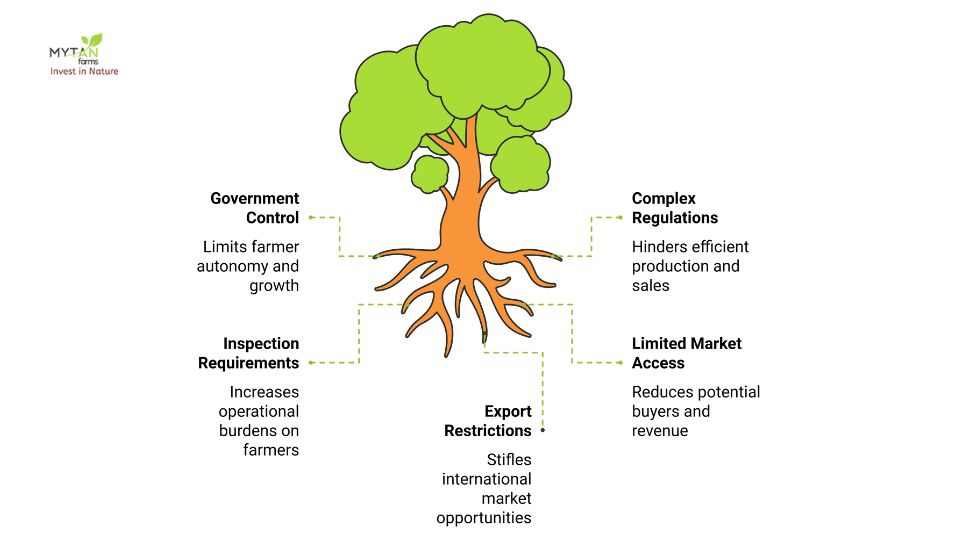
Sandalwood, a precious tree of Indian forests has been used in the country for thousands of years. Starting from spiritual ceremonies, and ending with exquisite fragrance, this valuable timber still enchants people all over the globe. Since there is increasing demand for aromatic oils and wood all over the world, most Indians are willing to cultivate this tree.
However, what most people do not know is whether you are legally allowed to cultivate sandalwood on your piece of land. This blog will take you through everything about starting sandalwood farming in India. It is good for you to know what is allowed and what is not.
Understanding Sandalwood Farming in India
What is Sandalwood?
Sandalwood (Santalum album) commonly called Indian sandalwood is a slow-growing, medium-sized, evergreen tree indigenous to India. The native people of this tree regard its heartwood as having a fine scent and medical use. The tree needs good drainage and can take between 15 to 20 years to fully mature into its sweet, woody smell.
Uses of Sandalwood
- Perfumery: The only material extractable from sandalwood is used in expensive perfumes and related end products. It also has a nice, warm, creamy smell and it helps extend the longevity of other fragrances placed on the skin.
- Medicine: Sandalwood has good antiseptic and anti-inflammatory qualities. In Ayurveda, it is employed for the treatment of skin diseases, respiratory disorders, and mental tension.
- Religious Rituals: Sandalwood paste is worn by Hindus during prayers and other ceremonial occasions. The wood is also burned as incense, particularly in temples, and is also used to make spiritual things such as prayer beads.
Economic Value of Sandalwood Farming
This suggests that sandalwood has significant economic worth in both the domestic and international markets. Their heartwood and oil are highly valued in all global markets, making them a perfect commodity for any farmer to invest in.
In India, demand exceeds supply, particularly in industries that produce fragrances, cosmetics, especially ayurvedic items.
International markets such as China, Japan, the Middle East, and Europe show significant growth tendencies, with buyers prepared to pay the highest prices for high-quality Indian sandalwood items.
Legal Framework for Sandalwood Farming

Historical Context
Sandalwood was formerly solely controlled by the Indian government. Until the 2000s, the government-owned all sandalwood trees, even those growing in people’s backyards.
Producers were prohibited to pick or sell trees without a government license, which hindered further growth while also increasing gathering.
Current Legal Status
Many states have now liberalized their sandalwood policies. Karnataka got its flag moving in 2001 by allowing farmers individually to grow as well as sell sandalwood.
The Indian Forest Act generally governs the sector, although various states such as Tamil Nadu, Kerala, and Maharashtra have devised rules that are beneficial to farmers because growers own trees, but they are still somewhat managed.
Key Legal Restrictions
Sandalwood trees should be notified to the local forest agency, and authorization to coupe must be acquired. Transportation includes the use of transit passes, while sales must be documented.
Forestry departments inspect plantations regularly and record information about each tree. Sandalwood can only be purchased by government-authorized customers, and exporting it requires specific authorization.
State-wise Regulations for Sandalwood Farming
Progressive States
Tamil Nadu, Karnataka, and Kerala lead India’s sandalwood farming revolution. Karnataka introduced private agriculture by providing farmers the complete ownership of all trees.
The Tamil Nadu registration procedure has also been simplified for farmers, as well as the state offers technical help. Kerala helps farmers boost their produce by providing packages or training sessions. These states are similarly equipped with ideal agricultural conditions and guaranteed markets.
Variation in Rules
Tamil Nadu, Karnataka, and Kerala are driving India’s sandalwood farming revolution. Karnataka implemented private agriculture by giving farmers entire ownership of all trees.
The Tamil Nadu registration procedure has also been streamlined for farmers, as well as the state provides technical assistance.
Kerala provides farmers with packages or training sessions to help them increase their output. These states are equally endowed with excellent agricultural circumstances and guaranteed markets.
Challenges in Sandalwood Farming
Protection Against Theft
One of the most important aspects of raising sandalwood trees is protecting them from various hazards. Mature trees are popular among park administrators because they add growing value, a single tree can cost lakhs, yet their value makes them prone to theft.
Producers require the installation of security features such as fences and the hire of security staff. The desperation has reached the point that some farmers chop their trees or install motion detection lights at night.
Complex Licensing Processes
Another aspect of sandalwood cultivation that might be overwhelming is the documentation involved. Growing is a perishable activity, thus farmers must seek multiple permissions ranging from registration to clearance to harvest.
Each state has unique requirements for forms, taxes, as well as waiting periods. Obtaining permissions can take up to six months, and even the simplest document might fall behind schedule.
Lack of Awareness
Today, some farmers have insufficient knowledge of the regulatory regulations governing sandalwood growing. Some people still believe that growing sandalwood is illegal, while others are unaware of the proper methods for doing so.
A lot of criteria, such as the registration process, market price, and purchasers’ circle of powerful networks, include knowledge that could improve farming but does not reach rural areas.
Opportunities for Sandalwood Farmers
Government Support
The government of India is also the largest investor in sandalwood through projects that include farming. Departments of forest offer seeds free or at subsidized rates while agricultural bank offer loans at low interest for sandalwood plants.
Some of the states offer technical skills and practice analytic services as a sample of soil tests. Sandalwood tree owners and local farmers can also be given insurance on their crops by certain agricultural products insurance.
Market Trends
Today, sandalwood farmland is in demand all over the world, especially for natural sources. It is a growing essential for producers of premium perfumes and natural cosmetics and cosmetics.
New opportunities include the growth of the market for organic and eco-friendly products as consumers are willing to overpay for certified Indian sandalwood.
Export Potential
Today international markets open a good opportunity for Indian sandalwood. It is used in the production of perfumes and as a product for religious use in Middle Eastern countries while Medi Spa and aromatherapy/natural necessity products are sold in Europe and United States markets.
Awareness regarding environmentally friendly sourcing has worked in favor of Indian sandalwood and has gained much appreciation from clients, especially from the premium end of the market.
How to Start Sandalwood Farming Legally in India?
- Check your state’s sandalwood rules and regulations, then get the necessary approvals from the forest office.
- It prefers well-drained soil and thrives in semi-arid climates.
- Discuss with the local agriculture authorities to learn more about host plants and available space.
- For example, the use of organic fertilizer and other traditional agriculture irrigation methods.
When first preparing for sandalwood farming, you must consult with agricultural extension agents and legal consultants who are familiar with forestry legislation.
These professionals could clarify all types of legislation, choose the suitable ground, and define critical errors. The pre-listed goals can also direct you to successful sandalwood growers and trusted buyers, making your journey easier and more profitable.
Benefits of Legal Sandalwood Farming
- For Farmers
The production of legal sandalwood provides a solid model for farmers to accumulate income over time. Unlike other harvested crops, these trees can produce a substantial income once they reach maturity.
Farmers can also grow other crops in between the sandalwood trees to create money while the trees mature and the sandalwood is ready to be harvested.
- For Investors
Sandalwood investment has a good chance of yielding a return in the future. Since unprocessed, natural sandalwood is becoming scarce, processed sandalwood from farmed trees is more valuable.
Globalization boosts demand while constricting supply, allowing investors to reap tremendous returns on their investments over a 15-20-year period of expansion.
- For Policymaker
Legal sandalwood plantations, in particular, eventually maintain the species’s long-term use and generate significant export profits. They generate rural employment, reducing the incidence of unlawful harvesting while also supporting ethical and sustainable forest subsurface activities.
This sector also attracts international investment and plays a vital role in not only protecting Indian biodiversity but also establishing India as a key provider of sustainable forest products.
Conclusion
Sandalwood farming in India offers a great mix of tradition, profit, and sustainability. With changing laws, farmers and investors now have the chance to grow sandalwood legally and make good money while protecting nature.
It’s important to follow the rules and get the right approvals to succeed in this field. By learning about local laws and using good farming practices, anyone can benefit from this rewarding opportunity.
Whether you’re a farmer, investor, or policymaker, sandalwood farming can help create jobs, protect the environment, and make India a leader in sustainable forestry.




